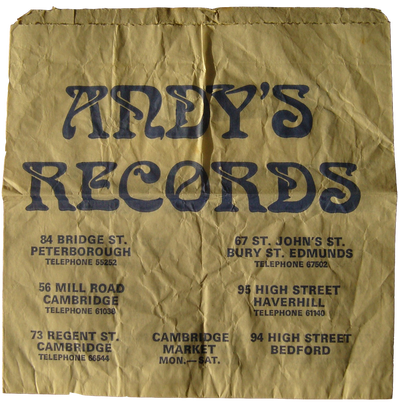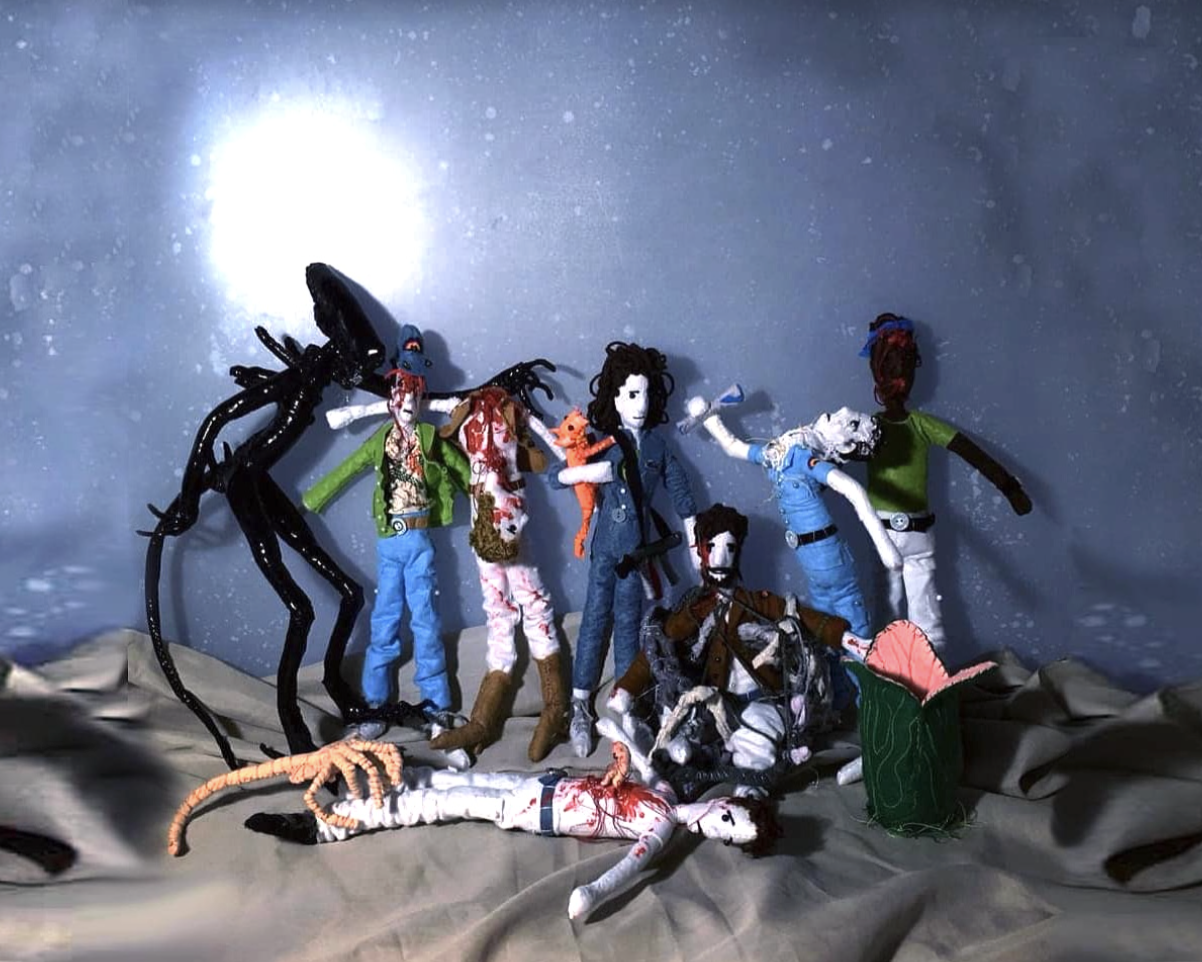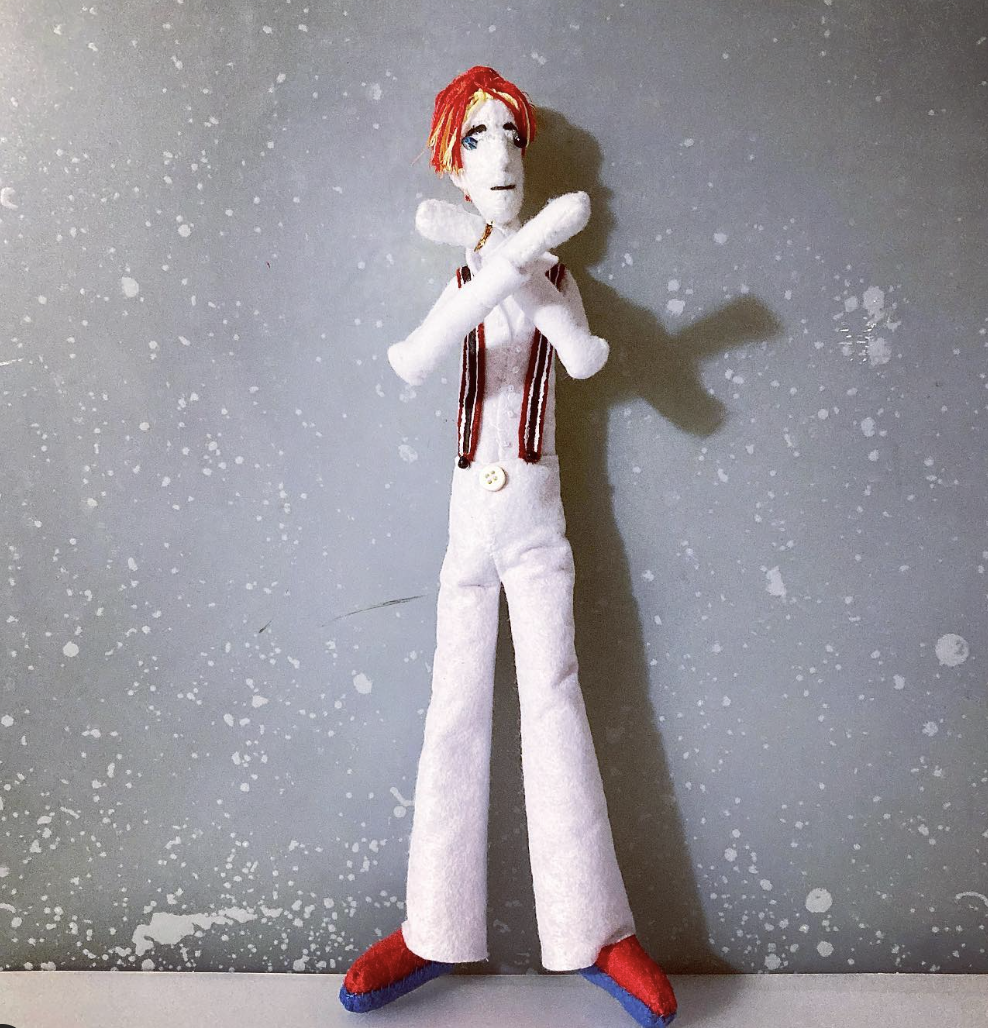Everyone is a Doll
Enter the magical world of John Lee Bird who turns his favourite people into dolls.
THE LONG READ
Tell us your story, your childhood and how you became an artist?
I was born in 1975, in Ipswich, Suffolk, to Maureen Ann and John Edward Bird. I'm the second child, my brother was born nine days before Christmas three years previously, and I was nine days after – always late to the event! My sister followed six years later.
Dad was a Postman; Mum was full-time mum after she'd given up working as a seamstress (mainly being head of the team making Marks And Spencer's Ladies' Lingerie). We lived in the suburbs of Ipswich, a five-minute walk to The Layers, a vast area of land that slowly melded into the woodlands by the River Orwell.
I always had to be involved in baking with Mum or helping paint the house or scrape wallpaper. I learned to read and write very early and hated it when my brother started school. I begged to go; the headmaster saw me upset at the gates so often that I was allowed to start school a term earlier than I should have done. Mum didn't want me to, but I guess she had more time to do dusting than listen to me nagging her to tell me horror stories, set me more mathematics questions, or listen to David Bowie or Abba albums.
It turned out that I didn't really like school; I hated the other kids and only wanted to hang out with my cousin Lyn and her neighbour Melissa. We were a team. My brother was a 'real boy' and a football nut, so I never enjoyed being around him – which always showed when we were forced to be in school photos together.
The team of me, Lyn and Melissa were inseparable. Every night we'd be together. Lost in our world of loving music and films, we were dreamers. Dreamers that worked hard at school to get the best grades, but dreamers nonetheless. Sometimes I'd sneak out of school for a pretend dentist appointment and go into the town centre to hang out in the record shops and then buy a rabbit from the pet store. We had seven rabbits by the time my mum went into the school and had me banned from leaving class unless she came to collect me.
I was a seven-year-old punk kid with a soft spot for pets, thanks to Parrot and Andy's Records staff, who seemed to like me harassing them for a job even though I was WAY underage. But when I let the girl in the record shop dye my hair blue and cut it Mohican style, it was a bit of a step too far for my mum and the primary school, and by this time, punk was dead anyway.
Debbie Harry in 1970’s
My Auntie Debbie, who looked like Debbie Harry, kept me interested in music. Every Friday, I'd be round watching The Tube with her, obsessing over the new musical acts, praying that Morrissey would be back waving more gladioli. Debbie used to let me watch horror films with her too, though I think the roller skates I was wearing when I watched The Evil Dead for the first time were a bad idea, and it put me off mushy peas, mashed potato and ketchup for a long time! But I was gutted when it was then banned in the UK because I was dying to make her rent the video again.
Secondary school was hideous. I really hated my classmates and only suffered each day because I knew I'd be able to report to Lyn and Melissa afterwards, and we could do our homework together and be in our world. I was terrible at sports, mainly because I'd have explosive nosebleeds whenever we got out onto the sports field, so I'd spend most of those lessons in the art department with cotton wool plugging my nose. Then Twin Peaks arrived and transported our imaginations further.
We got more and more into music and film and leapt at the chance to study dance when one of the teachers at school started an after-school dance group. He'd teach us techniques, and the music he played was the same as what we liked, so we studied Modern Contemporary dance for four years.
I turned down some dance talent scouts, kept my head down and secured top grades in every subject so I'd never have to go back to school ever again.
I took a Saturday job in the record store; Lyn and Melissa drifted a little as they got into boys, and there were no boys of my persuasion in the town, so I was left out. Initially intending to just work the summer before starting A' Levels in Art, Mathematics and English Literature, but the record shop won, I quit education and worked full-time (having lied about my age, I managed to go straight from Saturday boy into assistant manager role – Afterall I'd been hanging out in the record shop for so many years that the staff didn't believe I was as young as I was anyway.
I went to gigs, moved out of home, and moved in with my mate who needed help with the rent after her bloke had left her while she was pregnant. Me and my new best mate were the new team in town, and I became gay dad and was now manager of the record shop.
With a bit of money in my pocket, my days off became my time to get stuck into art. I'd always enjoyed art, but I'd been too occupied with getting good grades so I could leave school that I'd never focused fully on it. Plus, having dad responsibilities meant we were doing art stuff with the little 'un anyway, so we'd have loads of materials and paint and ink in the house.
I became immersed in art, with music, film and books fuelling everything: along with new life dramas and being gay in a backward town.The record shop started having problems because HMV had opened in town. Our little independent shop lost a bit of business, which upset the company's area manager, who then started to make my life hell – my bleached hair became his prime excuse. My 'boyfriend', who I'd only just met (six months of 'dating'), and the first person I'd gotten along with in 'that way' died suddenly, so I quit. I had a tiny bit of savings and spent the summer making a portfolio and applied for art school.
After a one-year Foundation course, I moved to London to study at Guildhall, which is now The London Metropolitan University. My art practice has always come from those that have influenced my life. Everything has a soundtrack or a roll of film flickering light onto it. Expanding the narrative and fuelling the fires of creation.
Early works came about from reading Jarman's notebooks and Burroughs and Gysin's (& Bowie's) cut-up processes, resulting in painting experiments that tapped into the unified action of understanding that everything can indeed happen all at once. We are what we 'eat', and we wear all our influences along with our hearts on our sleeves. Paintings built on layers of collage, memories threaded through and painted over until revealing the story of where I stood at that time.
Working with Big Wide Talk, making gigantic installations for children to explore, new worlds built from fabric, paint and glue to build new stories.
BEFORE ENCORE By John Lee Bird
I spent ten years documenting friends that were breaking out onto the music and performance scene - along with a favourite barmaid and a landlady or two that had fuelled my creative development with an extra whisky or three. Large-scale canvases cementing everyone depicted as icons of my time. Idols.
Wading through a destructive domestic violence relationship by shining a light on the underworkings of my partner's body, figuring things out while still holding him on a pedestal. Art as therapy turned into iconography. Working things out from under the skin. Peeling the idol apart to begin again.
Collages became part of a similar process. Icons torn and reshaped, amalgamations of influence reshaped and reworked to enable a sense of moving on and finding a path forward.
Deconstructing the line to find the essence of motivation through documenting the changing time. Drawings simplified to simple lines drifting through empty space.
And icons again, in lino cut form, searching to remember childhood stories, brought out by focussing on the icons of that time.
Then a spinal condition, trapped at home, and remembering that I used to love to stitch. Idols became dolls. Bowie first, always first, and then everyone else! Back to simplicity - in a detailed way. Paying tiny heartfelt tribute to influence again. Another grand collection held dear.
Three years of daily stitching, hours upon hours upon end, getting all dolled up! Tributes to the figures that have inspired me throughout these years of producing work and finding that it is all interlinked. Stitching the line and connecting 25 years of mass production in intimate ways.
Five strokes on, it is all interwoven, hung together, forming a bigger picture. All these little things are still just a stitch in time, 'in the grand scheme of things'.
John Lee Bird is a doll. Self portrait. Courtesy of the artist.
Do you have a favourite story? From childhood? A fable? Or a story that you've never forgotten?
The arc of Ellen Ripley.
I was off school with glandular fever, seven years old, and Alien was on tv. (11th July 1982, according to Wikipedia) and I was ‘sleeping’ on the sofa. My Mum didn’t want to wake me, and because she was engrossed in what was unfolding on screen, she didn’t notice that from under the crocheted blanket, my little feverish eyes were soaking up the drama.
I loved the character of Ripley. She turned from a by-the-book-worker-Mom into a heroine. A survivor. I’d not seen a woman like this on-screen before. I’d loved Wonder Woman, Lynda Carter had a golden lasso of truth and packed a punch, but she had superpowers. This Ripley character was a real woman, battling it out against the best on-screen monster I’d ever seen. I’m still obsessed with her character, and Sigourney, and the whole Alien franchise. It’s a film I revisit almost monthly – much to my flatmates’ dismay!
Alien is a doll.
How does storytelling feature in your work?
Storytelling is life. It’s the essence of being. We all are a story, and stories are what fuel our understanding of how we manoeuvre and manage our own stories as we live them out.
I’ve made three “childrens” books over the past few years—a little twisted and dark, but friendly to all. I think stripping my writing down for a purpose helped me wrestle with how I approach text in my practice.
I’ve always used text and stories as a basis for my work, incorporating texts into everything. I hid my own writing for years. I kept notebooks of prose, ideas and memories. Sometimes these words would be scribbled onto canvases, but text scrawled so obliquely that only a few words would be legible. The words were kept secret, safe for when I was ready to let them out fully. I’ve no idea why I did this. I’ve been looking
back lately and seeing them in a different way. Texts that were supposed to just ignite the sparks to form images now feel more important than the images I was making. So I’ve started leaking some of these texts out…and it’s probably why I’m talking and typing the way I am now. Maybe it’s just being older, none-the-wiser, and letting things go.
Tell us about your process?
The designing process could be faster and sometimes takes longer than I would have wanted, but things need to be right and perfect. Sometimes an idea doesn't work on the first go, so I need to find a solution, and that's why it might end up in the next collection. All my collections are time and material limited, making them more valuable to collectors. I learn new things along the way. The rest is a secret.
Tell us about your process of doll making?
Here’s the “official” bit: The project began at the beginning of lockdown with a crippling spinal condition. I felt the urge to return to working with fabric and textiles, the way I’d begun my art degree in 1997. I found a box of felt in my studio and decided on a whim to make a David Bowie doll. Just over three months later, I’d made 69 Bowie dolls; one to mark each year that “The Man Who Fell To Earth” graced us with his existence—covering every stage of his career.
Celebrating the life of my idol and all the costume collaborators that brought his creativity to our eyes, an obsessive tribute. My library of Bowie’s music as the soundtrack to my endless stitching. The project spiralled, and I wanted to make more. Looking at my vast music collection, I decided to dive in and bring everyone to life in felt form. Immersing myself in their sounds as I stitched. Making one a day became an obsession and driving force, and my daily entertainment.
Four hundred dolls later, I started to look at my favourite films and tv moments, ALIEN, The Exorcist, Twin Peaks, Buffy The Vampire Slayer and many more. Finally, deciding to stop stitching after three whole years in March 2023. Working with textiles gave me a comfortable way to work and an exciting challenge to attempt portraiture of a different kind: over the years, I have worked on portraits through various mediums, including a ten-year project documenting performers in large-scale paintings, collage work and drawings; but I’ve never explored portraiture in textile work until now. Each doll is 13 inches tall. Lovingly hand-sewn from felt with beads, buttons, wool and occasionally extra fabrics and embellishments.
David Bowie is a doll
Combining my love of music, films, and fabric gave me a sense of purpose and freedom to play and helped me through the darkest moments. But basically, I was waking up each day and randomly pulling either a film or cluster of CDs from my collection, and that would be that day’s project. Each doll is hand-stitched and takes between 8 - 14 hours to make. I think it’s becoming clear that I’ve got a rather obsessive nature, and that, coupled with the distraction from spinal pains, stitching provided was enough to keep me going. Reaching for more felt, shuffling boxes of fabric in my studio, and changing cotton and needle; that was part of my physio and getting movement into my daily routine. Each day although confined to the home, I’d have still created something – and explored the ‘world’ around it, diving deep into wormholes of out-takes and live recordings, or interviews and fan theories - all playing in the background while I stitched.
Who or what is your greatest influence?
Aside from Bowie it’s Derek Jarman. Who I love for similar reasons; fearlessness that’s the key. Both worked in multi-disciplinary ways and, in my eyes, were masters at all. Jarman’s films were part of my sexual awakening.
Derek Jarman
Through studying Jarman and reading the publications of his notebooks, I found the type of queer I wanted to be. Plus, I discovered Jarman after my dance teacher told me I should investigate his work; he’d caught me having a quick sniff of boxer shorts, and although he was probably a bit shocked, he calmly smiled and, with a knowing wink, told me to watch Sebastiane that was being shown on Channel 4 that evening. The following week he took me aside and had a gentle chat about how it was ok to be gay (even at the time of Thatcher) because I was a part of a bigger community who would always be fighting fearlessly for their voice.
What’s the best advice and worst advice you’ve been given?
This is something my Grandfather said to me one day at the beach, it’s always stuck with me. “There will always be a certain amount of sand that slips through the fingers, but remember, You can always pick up another handful.” John William Grimwood
The worst advice was probably listening to and following my own heart and dating that bloke called Chris (the first Chris I dated) who smashed my face into a kitchen cupboard for a few hours; though I did escape and eventually made lots of art about coping with domestic abuse… and I’m starting to trust my heart again, but that’s pretty easy when there’s only dolls and my cat to consider.
What motto do you live by?
Make something every day.
And
NEVER STOP.
John Lee Bird will be contributing to the next edition of The Lab Mag.
Stay tuned…














